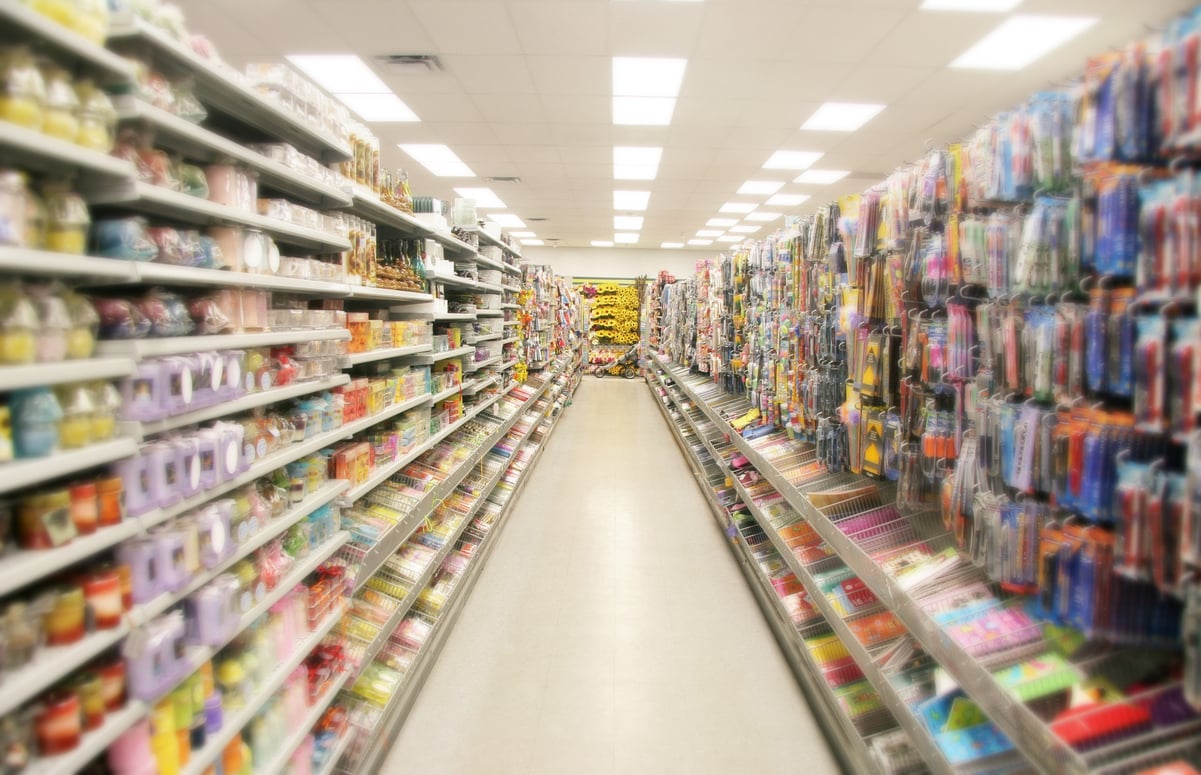
The sky's the limit for Dollar General as it focuses on its next stage of growth. Source: Mike Mozart via Flickr.
A nearly 40% increase in its stock price over the past year shows Dollar General (DG 1.97%) to be a company that's firing on all cylinders. While it lost the acquisition of Family Dollar to rival Dollar Tree, that hasn't slowed its pace of growth, and arguably Dollar General investors should be thankful the bid was rejected.
Now the dollar store leader can concentrate on growing its store base without needing to integrate a damaged business into the fold. But after having come so far so fast, has Dollar General hit its pinnacle?
While there's no guarantee Dollar General's stock will rise from here, I think there are still some factors that could push it higher over the next few years. Here are three.
Reason 1: Additional investments in consumables
Dollar General achieved 5% fourth-quarter comparable-sales growth that was spread evenly between consumable goods and non-consumables, such as clothing and home goods. While sales of non-consumables have grown for 4 straight quarters, it's in consumables that Dollar General is making great strides and gaining even more market share.

Deep discounts have never looked so good as they do at Dollar General Markets, the concept store the dollar store retailer is using to learn important lessons. Source: RustyClark via Flickr.
The General has been growing its Dollar General Markets stores, which offer fresh produce and groceries, and has been learning how to apply those lessons to its regular 7,500 square-foot stores, which -- with sales of $223 per square foot -- are exceptionally productive.
Taking the best of its other concepts and adding them to the standard Dollar General store will bolster the company's competitive leadership position. This is particularly critical due to the strong competition from mass merchandisers like Wal-Mart and Target, which are experimenting with smaller-footprint stores, and from grocery chains like Aldi that take a bare-bones approach to the supermarket concept.
Other steps Dollar General is taking include expanding the availability of tobacco products. It's starting to lap the introduction of tobacco into its stores and is seeing positive year-over-year gains.
The industry watchers at Management Science Associates said that while convenience stores remain the primary outlet where consumers buy tobacco, accounting for 47% of retailers and 62% of volume, dollar stores are the real growth story. While they currently only account for 5% of the retailers selling tobacco products and represent just 1% of the volume, tobacco sales volume at dollar stores surged 42% last year, compared to a 1% gain at convenience stores.
Reason 2: Private-label brand expansion
Across retail, store-brand growth has exploded. According to the market research folks at Nielsen, some 67% of consumers believe private-label goods offer "extremely good value for the money," and they've gained a 17.5% dollar share of the market. The only reason it's not higher is that branded goods have increased their promotional activity to protect their market share.
Dollar General is in the middle of a repackaging effort to enhance its own private-label offerings across both consumables and non-consumables. When the reset is completed, by mid-year, it anticipates building on the 6% gain in private-label SKU count and 24% penetration it achieved last year. (Penetration is the number of consumers who buy or use a particular product divided by the market size.)
While private label goods are more affordable to consumers -- and the Nielsen survey says 70% of consumers purchase private-label goods to save money -- they also offer higher margins for the retailer. On average, the profit margin on private label goods is 10% higher than for similar branded products.

Dollar General is looking to increase comps, traffic, conversion, and penetration by focusing on its deeply discounted core. Source: Random Retail via Flickr.
Reason 3: Renewed focus on core business
With a name like Dollar General, you expect the store to offer deep-discounted pricing, but until its acquisition of Family Dollar, Dollar Tree was the only real national pure play in the industry. Both Dollar General and Family Dollar sell quite a lot of goods not only higher than $1, but above $5, too. About 25% of Dollar General's goods are priced above $5.
Dollar General, though, is committing to strengthening its value proposition in the $5-and-below price range. More than 75% of its SKUs -- or 76% of sales in the fourth quarter -- were items priced at $5 or less, which Dollar General calls the "sweet spot" of affordability.
A penny for your thoughts
The deep discount retailer has not made many missteps since returning to the public markets, and along with the initiatives outlined above, it continues to keep its shareholders uppermost in mind. It recently initiated a $0.22 per share annual dividend and plans to buy back some $1.2 billion worth of stock this year. That's equal to 62% of all the stock it's bought back since it went public in 2009.
While even the best-laid plans go awry, if Dollar General is successful in hitting most or even some of these goals, it should help its stock continue rising.






